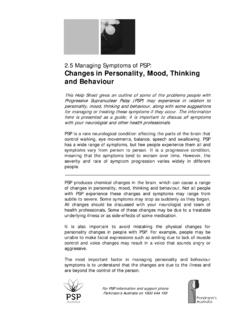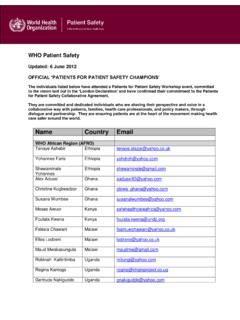Transcription of 1.1 What is PSP - PSP Australia
1 Introduction: what is progressive supranuclear palsy ? This Help Sheet gives a simple introduction to the condition known as progressive supranuclear palsy (PSP for short). It explains its causes and symptoms, and gives information about who the condition affects and how it is diagnosed. It also suggests where you can go for further information and support if you or someone you know has PSP. The information here is presented as a guide; it is important to discuss all symptoms and management strategies with your neurologist and other health professionals.
2 PSP is a rare neurological condition affecting the parts of the brain that control walking, eye movements, balance, speech and swallowing. PSP has a wide range of symptoms, but few people experience them all and symptoms vary from person to person. It is a progressive condition, meaning that the symptoms tend to worsen over time. However the severity and rate of symptom progression varies widely. P progressive means the symptoms get worse over time S supranuclear refers to the part of the brain that is affected P palsy means a weakness or paralysis in a part of the body At the moment there are no treatments that are known to cure PSP and we do not know of any way of preventing it from occurring.
3 Treatments, therapies and strategies are available to help people with PSP and their families and carers to make the most of living with the condition. PSP occurs in only about five or six people per 100 000 (this is similar to the numbers of people with motor neurone disease). It is a difficult condition for doctors to diagnose, so actual numbers of people with PSP may be higher. Approximately 180 Australians will develop the first signs of PSP each year and currently around 1300 Australians are living with PSP.
4 Only 22 per cent of people with PSP are given the correct diagnosis in the first 2 years, with many receiving an initial diagnosis of Parkinson s disease due to the similarity of symptoms. For PSP information and support phone Parkinson s Australia on 1800 644 189 PSP was first described and named by doctors in 1964. Before then people with the condition were thought to have Parkinson s disease. PSP is sometimes called Steele-Richardson-Olszewski syndrome after the doctors who first described the condition.
5 Other terms sometimes used for PSP are Richardson s disease , PSP-parkinsonism or (PSP-P) and pure akinesia with gait freezing . what causes PSP? PSP is associated with an over-production of a protein called tau in certain areas of the brain. Clumps of tau (called tangles ) build up and these are believed to cause damage to nerve cells. We do not know what causes the over-production or the build-up of tau, though research is currently underway. Researchers have found no evidence of any links between PSP and environmental factors such as exposure to toxins or chemicals.
6 Research is ongoing in Australia and overseas. Contact Parkinson s Australia or your neurologist for further information about participating in PSP studies. Who gets PSP? People with PSP usually start to have symptoms between the ages of 60 and 70. PSP can affect men and women from all nationalities and lifestyles. Many of those affected have always lived a healthy lifestyle. Is PSP inherited or passed on through families? PSP does not run in families. However, a common genetic type has been found to be more common in people with PSP than the rest of the population.
7 In other words, there may be some genetic susceptibility that makes some people more at risk than others, but PSP rarely affects more than one person in a family. Can it be treated? Treatments and therapies are available to help manage symptoms of PSP, however, there is no cure and we do not know of any way of slowing its progression. It is important that people with PSP see a neurologist, preferably one with expertise in movement disorders such as PSP and Parkinson s. Depending on symptoms, it is also important to seek the advice of other health professionals with expertise in the condition, such as a physiotherapist, occupational therapist, speech pathologist (speech therapist) or counsellor.
8 Parkinson s Australia can provide information about neurologists and other health professionals in your area. For further information about treatments, therapies and strategies to manage the symptoms of PSP see the series of Help Sheets on managing symptoms from PSP Australia . Page 2 Is PSP fatal? PSP can not be cured, so everyone with PSP experiences deterioration prior to death. As the condition progresses, people with PSP are at risk of developing serious complications, such as pneumonia or choking caused by swallowing difficulties or head injury caused by falls.
9 These complications can be fatal. The rate of progression with PSP varies significantly from person to person. The average life expectancy after diagnosis is approximately seven years, which means that half the people with PSP will live longer, some up to 15 years, and half will live shorter, even as short as 3 years. Research into PSP is currently underway, giving us hope for the future, particularly in relation to more effective management of symptoms. what are the symptoms of PSP? PSP affects different people in different ways.
10 It has a wide range of symptoms. These get worse over time and can start to have a significant impact after five to six years. Early symptoms of PSP may include: Problems with walking (or gait ). These may include stiffness, awkwardness or problems with balance and unexplained falls, particularly backwards. A feeling of dizziness. Slow movements. Facial stiffness. Problems with eyesight, which may be described as tunnel vision, blurring, double-vision, dislike of bright lights and/or difficulty focussing.





